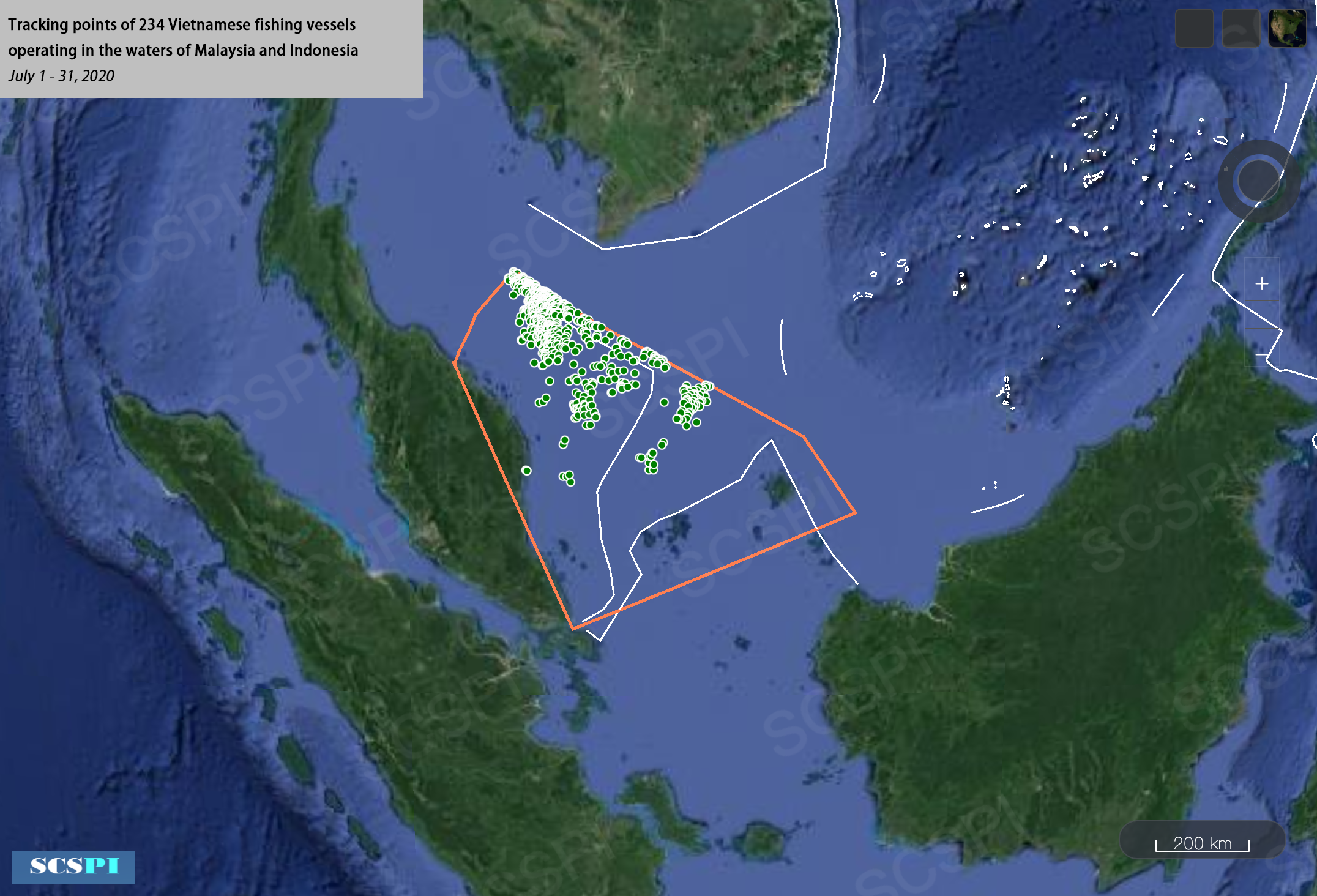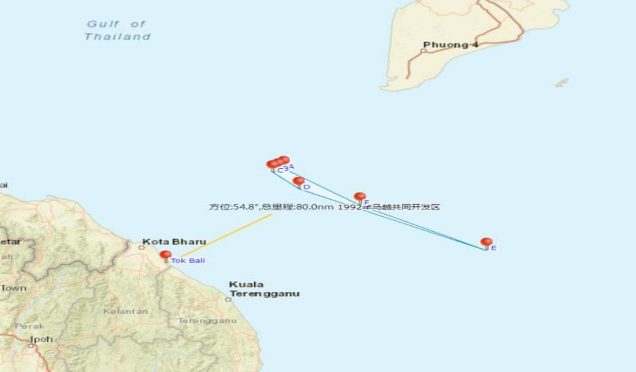In 2020, Vietnamese fishermen have frequently clashed with Indonesian and Malaysian law enforcement forces at sea, even causing casualties and raising concerns. In fact, the issue of fisheries has been a top priority in the competition for resources in the South China Sea and is the most likely potential trigger for maritime conflicts. For many years, the South China Sea has been plagued by fishing disputes between coastal countries, with incidents of illegal fishing and fishermen's arrest. 2020 witnesses an increase in the number and scope of Vietnam's illegal fishing vessels, resulting in conflicts with several coastal countries and becoming the most serious challenge to maritime security in the South China Sea.
I. Vietnam's fishing conflicts with Indonesia and Malaysia in 2020
Since 2020, Vietnamese fishermen have engaged in unusually frequent illegal fishing activities in the non-contested waters of the South China Sea and in the near coast of surrounding countries, often causing friction with neighboring countries. China, its Southeast Asian neighbor and other Pacific island countries have all been subjected to illegal fishing by Vietnamese fishing vessels to varying degrees. According to the "South China Sea Strategic Situation Probing Initiative" (SCSPI), from February to August 2020, there were 4872, 9152, 9208, 9579, 9646, 9766, 6450 Vietnamese fishing vessels operating in the entire South China Sea, including the Gulf of Thailand, covering the coastal waters of Vietnam, the Gulf of Tonkin, Hainan Island, the waters off the coast of Malaysia and Indonesia, the southwest waters of Taiwan, the Paracels, the Spratlys, and the coastal waters off Malaysia and Indonesia.[1]Hundreds of Vietnamese fishing boats intrude into the waters off West Malaysia and the waters off Indonesia's Natuna Islands every month. The recent frequent friction between Vietnamese fishing vessels and Indonesian or Malaysian law enforcement forces also corroborates the rampant activities of Vietnamese fishing vessels.

Schematic diagram of the intrusion of Vietnamese fishing vessels into the waters bordering Malaysia and Indonesia in July[2]
1. With Indonesia
Since 2014, fishing disputes between the two countries have been intensifying and escalating, with many incidents of arresting fishermen and even blowing up fishing boats. According to Indonesian statistics, from 2014 to the end of 2019, Indonesia blew up a total of 556 illegal fishing vessels, of which Vietnam accounted for 321.[3]
Into 2020, the Vietnam-Indonesia fisheries dispute intensifies.

According to incomplete statistics, 18 Vietnamese fishing boats have been seized by Indonesia(including one that was rammed and sunk), 147 Vietnamese fishermen have been arrested, and one person has died and four are missing in the course of the conflict. Fisheries disputes between the two countries have led to increasing risks to maritime security.

Diagram of accident location on 19 April 2020[4]
2. With Malaysia
The Vietnam-Malaysia fisheries dispute has a long history, with Vietnamese fishing boats frequently entering Malaysia's shores to fish, leading to fishing conflicts between the two countries. From 2006 to 2019, Malaysia has detained a total of 748 Vietnamese vessels and 7,203 fishermen for illegally fishing in Malaysian waters, and Malaysia also loses up to 6 billion ringgit (US$1.5 billion) annually due to illegal fishing.[5

Since 2020, Malaysian law enforcement authorities have toughened their measures against illegal transboundary fishing by a large number of Vietnamese fishing vessels, and the fisheries conflict between the two countries has been escalating.

Possible site of the conflict between Vietnam and Malaysia on 16 August[6]
Actually, back in October 2017, the European Union issued a "yellow card" warning to Vietnam for persistent fishing violations, ordering it to rectify the situation or face trade sanctions.[7]Subsequently, Vietnam introduced a series of improvement measures. On November 21 of the same year, Vietnam amended the 2003 version of the Fisheries Law to require all fishing vessels over 15 meters in length to be equipped with satellite positioning equipment, which came into effect on January 1, 2019. In January 2018, Vietnam published the White Paper on Combating Illegal, Unreported and Unregulated Fishing (IUU).[8]In May 2019, the Prime Minister of the Government of Vietnam approved the establishment of the National Steering Committee on the Prevention and Control of Illegal Fishing (IUU). Vietnam has also taken the initiative to respond to and promote initiatives related to the fight against illegal fishing under the ASEAN framework. However, judging from the recent increasing illegal fishing activities in Vietnam, it is clear that relevant regulations are not fully implemented, fisheries management remains inadequate and fishermen are not aware of the law. In November 2019, the European Commission's inspection mission still expressed dissatisfaction with the second assessment inspection of Vietnam's fight against illegal fishing, decided to extend the "yellow card" for six months until June 2020, and recommended that the Government of Vietnam take further strong measures to prevent illegal fishing by its fishing vessels in the waters of other countries.[9]
Ⅱ. The reasons of these frequent fisheries disputes
The first one is about the development stage that Vietnam stands at the moment. As an important industry in Vietnam, fisheries play an essential role in the social and economic development, accounting for 4% of the country’s total trade volume.[10]However, with the increasing high sea fishing capacity, depletion of offshore resources, adjustment of government fishery policies and drive of domestic and foreign markets, Vietnam's already surplus fishery production capacity has flooded into the South China Sea. Many Vietnamese fishermen even venture into the coastal waters of their undisputed neighbours for illegal fishing. To boost the fisheries development, the scale of fishing fleets in Vietnam's 28 coastal provinces are expanding rapidly. According to the Vietnamese data, the number of the country’s fishing boats increased from 41,000 in 1990 to 108,500 in 2018, seeing an increase of more than 160%. The actual numbers are far more than that. In addition, the fishing capacity of Vietnamese fishermen is constantly improving. The number of high-powered boats surpassed 400 horsepower increasing by 30% between 2016 and 2018 alone.[11]In Bà Rịa-Vũng Tàu Province, a southern province of Vietnam, the engines of the traditional trawlers are usually less than 90 horsepower, but now increasing engines are used as high as 600 to 900 horsepower. With the rapid improvement of fishing capacity, by 2018, Vietnam's total aquatic product volume has reached 7.757 million tons, up 6.1% compared with the previous year.[12]The exports of seafood products reached 10.5 billion US dollars in 2019, increased 23% from 2017, making Vietnam the world's fourth largest exporter of seafood products.[13]
Besides, the Vietnamese Government indulges illegal fishing to advocate its maritime policy and claims. In the South China Sea, Vietnam often takes actions to promote its "sovereignty claims" in various forms, among which encouraging fishermen to invade the coastal waters of the neighbours is one. To make it a "maritime power", Vietnam strongly supports high sea fishing, and regards every fisherman who goes out to fish as a "living monument" and the most powerful force to “safeguard” the sovereignty of islands.[14]Over the years, the Vietnamese government has constantly adjusted its marine fishery plan, aiming at expanding its offshore fisheries. The Vietnamese Government encourages its fishermen to build large fishing boats, provides long-term fuel subsidies, soft loans and other financial support, and facilitates Vietnamese fishing boats’ upgrade and renovation[15]Following the promulgation of Decree No. 67 on a number of fisheries development policies in 2014, 1,032 new vessels have been built by 2019 largely assisting Vietnamese fishermen to carry out high sea fishing.[16]By 2018, Vietnam had set up 3,055 Marine Production Units to “defend” maritime sovereignty and security, involving about 19,700 fishing boats and 128,000 fishermen.[17]Vietnam has stepped up its Maritime Militia building in recent years, and the fishermen are becoming more adventurous and aggressive. In December 2019, Vietnam not only reorganized the Maritime Militia in 14 coastal provinces and cities, but passed the amended Law on Militia and Self-Defense Forces to provide better legal guarantees for Maritime Militia activities. It is estimated that 8,000 of Vietnam's fishing boats and 1.22% of its maritime labours are members of Maritime Militias of fisheries.[18]Instead of managing illegal fishing effectively, the Vietnamese government has indulged its vessels to sail into disputed waters, using them as Maritime Militias strength to assert its maritime rights. The policy that the Vietnamese Government upheld has in part facilitated illegal fishing in the disputed waters and heated up the fishing disputes with neighbouring countries.
Furthermore, the Indonesian government and the Malaysian government have adopted severe measures to combat IUU fishing. In the absence of successful initiatives and mechanisms in the region, Malaysia and Indonesia have taken tough measures to combat IUU fishing.[19]Indonesia's President says illegal fishing costs the country's fishing industry more than $20 billion a year.[20]Findings suggested that Indonesian skipjack tuna fishermen would lose 59% in catch and 64% in profit by 2035 compared to current levels if no action was taken.[21]After Joko Widodo coming to power in 2014, he starts to combat illegal fishing through mobilizing all units including Indonesian Navy, the Ministry of Foreign Affairs, the Ministry of Marine Affairs and Fisheries and so on, and setting up the 115 anti-illegal fishing task force. Further cooperating with the Google, the Indonesian Fisheries Ministry spots illegal foreign fishermen from space with advanced satellites and software capabilities.[22]Indonesian Navy has hunted down violators and blown up their boats in public spectacles to show deterrence and firmed resolution in defending sovereignty. The “blown up” policy effectively frustrates the illegal fishing in Indonesian coastal waters, seeing a 90% of decrease in illegal fishing and 25% dropping in the volume of total catches.[23]The disagreement on fishing between Vietnam and Indonesia is expanded following a series of practices. Malaysia is also stepping up its crackdown on IUU fishing. In particular, since May 2019, the Malaysian Maritime Enforcement Agency has jointly coordinated with the police, navy, fisheries and immigration department in launching a multi-agency task force operation called Op Naga, which focuses on combating illegal activities at sea.[24]In 2020, Malaysia continued to launch OP KUDA LAUT to further crack down on illegal fishing by foreign vessels. So far, 45 foreign fishing vessels have been detained and 502 crew members have been arrested.[25]
Ⅲ. A prospect
Vietnam's IUU fishing activities in the South China Sea have buried a mine in the marine security of the region, further tensioning the present situation. On the one hand, the balance of the fisheries and marine ecological within the region has been hazarded, parts of the marine resources have been depleted, and the sustainable development of the ecological environment and fisheries in the South China Sea are under threatening. On the other hand, the worsening fisheries disputes among coastal states in the South China Sea, as well as the resulting violent incidents and nationalist antagonisms have become a major challenge affecting the regional security. The incessant fisheries disputes have caused a longstanding impact on the normal fishery production system in the region, impeding the potential fisheries cooperation in the South China Sea.
First, The Vietnamese government should face up to its own problems and restrict its illegal fishing boats crossing the lines. With the indulgence of the Vietnamese government, Vietnam's illegal fishing has become increasingly rampant which leaves the room for more violent conflicts. To alleviate such tensions, the Vietnamese government need to be frank to the fact that many Vietnamese fishermen are being rampant on the illegal fishing activities in the South China Sea. By recognizing the insufficiency of its fisheries management policy, and understanding the damage of illegal fishing caused to the coastal states and regional security, the Vietnamese government then takes effective measures to strengthen its fisheries management, controls the number of boats, and raises the law-abiding awareness of the fishermen. Besides, the Vietnamese fishing policy should be adjusted constructively, such as cancelling subsidies to the illegal fishing activities, improving the capabilities of its law enforcing agencies on inspection, control and supervision of illegal fishing, and fulfilling relevant international obligations. A policy option that the Vietnamese government could adopt is to arrange fishing moratorium, which will contribute to the sustainable utilization of regional fishery resources and a healthy development of the fisheries in the South China Sea.
Second, Vietnam should give up its intention to expand its control over the sea through indulging illegal fishing, which not only is unavailable in rule-based order but also is harmful in practice. Land dominates the sea is a worldly recognized international law principle, not in reverse. Maritime rights and interests, including fishery resources, are derived from land, and the so-called fishery production activities alone cannot "safeguard" or even "contest" the sovereignty over land territory. In reality, these encroachment activities into other countries' territorial waters or even inland waters will only cause competing responses from relevant countries and add the risks on the sea.
Third, a future fishery production order in the South China Sea need to be established and maintained well under the consensus between Vietnam and the other regional countries. In general, the marine fishery production order involves fishermen and law enforcement agencies. The current situation has revealed a tendency that the Vietnamese fishermen adopting violence to resist the laws is becoming increasingly prominent. Noticeably, violent resistance like using knives and homemade bombs have been witnessed in the past several cases, which endanger the personal safety of law enforcement officials. Meanwhile, gaps and weaknesses exist in law enforcement procedures and rules for the use of weapons of some regional countries’ law enforcement agencies, for instance, Indonesia’s “blown up” policy. Therefore, Vietnam need to reach consensus with relevant countries on fisheries cooperation and management mechanisms. In this regard, Vietnam and Malaysia have started to work collaboratively, namely, established corresponding law-enforcement cooperation and notification mechanisms. Such cooperation needs to be encouraged and developed in depth covering the topic of fishing conducts management, law enforcement procedure, etc.
Fourth, specific arrangements for managing fisheries disputes should be covered in the current multilateral mechanisms, especially the ongoing the Code of Conduct (COC) negotiation. It is time to consider to input relevant clauses or annexes to ensure the sustainable development of fisheries in the regain, and formulate enforcement and interaction norms for fisheries law enforcement agencies to prevent the occurrence of maritime fisheries disputes and effectively manage crises.[26]




